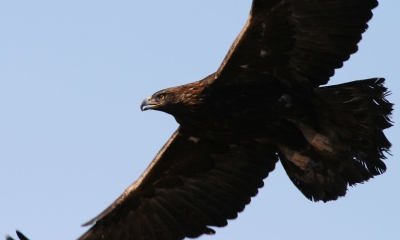
Raptors

Types of Raptors
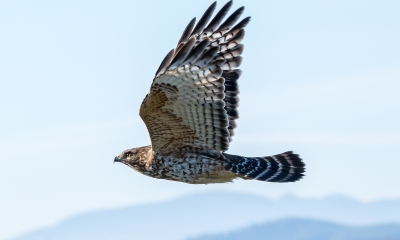
A medium-sized hawk, the Red-shouldered hawk has bold black-and-white flight feathers and rusty shoulder patches. Seen in flight from underneath, especially when lit from the sun, its wings show a translucent 'window' near the tips.
It relies on perches for hunting and is closely affiliated with wooded wetlands and riparian bottomlands.
In the breeding season this hawk is found in moist woodlands with at least a few deciduous trees. It prefers riparian bottoms, especially those near shallow wetlands or open meadows. In winter, it may use more open lands such as found in the Rogue and Willamette valleys, depending on perches available for hunting.
Hear the call of the Red-shouldered hawk
Photo by Michael Geiger

Swainson's hawks are medium-sized buteos, smaller than Red-tailed and Ferruginous hawks.
Plumage beneath varies along a continuum from very pale to nearly black below. Lighter-plumaged birds have a distinct chest band. They have relatively long, pointed wings that contribute to superior flying skills. The dark flight feathers contrast with paler wing lining in all but the darkest birds.
It breeds in the bunchgrass prairies east of the Cascades with the highest concentration in the foothills of the Blue and Wallowa mountains. It prefers open country and has little need for numerous trees since it forages extensively while in flight and may include only the nest tree in its home range.
The Swainson's hawk is an Oregon Conservation Strategy Species in the Blue Mountains, Columbia Plateau, East Cascades, and Northern Basin and Range ecoregions.
Hear the call of the Swainson's hawk
Photo by Kathy Munsel, ODFW

One of the most familiar sights along the roads of Oregon is a Red-tailed hawk soaring high on the sky over a field, or perched on a utility pole, waiting patiently for prey.
Red-tailed hawks are large-bodied raptors with relatively broad wings. The back is mottled brown, and the tail of mature birds is orangish red with a thin, dark subterminal band. Perched birds can be identified from behind even when the tail is concealed by the white mottling on the scapulars forming a faint 'V'. Most individuals can be assigned to one of two color morphs, light or dark. Both are similar from the back, but underneath the light-morph birds are largely white or off-white with a belly band of varying extent and darkness.
It is found throughout the state in every habitat and at every elevation, though they are scarce in more densely forested areas.
Hear the call of the Red-tailed hawk
Photo by Chuck Gardner
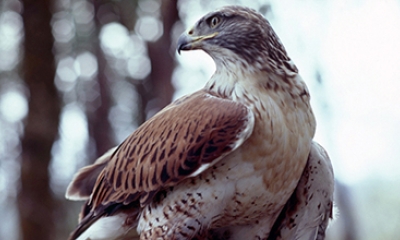
This largest of Oregon's hawks inhabits the most open country of the state's buteos, and watches over its home range on long, motionless wings for extended periods in search of prey. Ferruginous hawks are sensitive to human disturbance and tend to reside in remote areas.
They occur in two color morphs, but dark-morph birds are rare in Oregon. Light-morph birds are white below with few markings except for the ruddy-colored leg feathers. The back and wing coverts are rust colored and the tips of the primaries and end of the tail tend toward dark smoky gray.
It is an uncommon to rare resident in the open landscapes east of the Cascades. It is most common in northern Malheur County and along the foothills of the Blue Mountains.
The Ferruginous hawk is an Oregon Conservation Strategy Species in the Blue Mountains, Columbia Plateau, and Northern Basin and Range ecoregions.
Hear the call of the Ferruginous hawk
Photo by Jim Collins, ODFW

Characteristic of open country and cold weather, the Rough-legged hawk can be found soaring over exposed terrain or perched on utility poles across much of the state in winter.
The rough appearance of its legs comes from the feathers covering their length, an adaptation that provides extra warmth in frigid weather. In flight, dark wrist patches and belly help identify this large buteo, though like other hawks it is subject to much variation in plumage. From a distance it frequently appears to have a frosty upper half.
It often hovers over fields while hunting, a behavior that is rare among most other buteos.
Hear the call of the Rough-legged hawk
Photo by David Bronson, ODFW
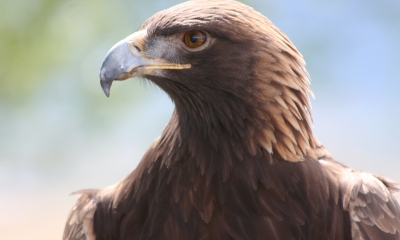
The Golden eagle is the largest soaring raptor inhabiting open country and mountainous terrain in eastern Oregon. A powerful and skillful hunter, the Golden eagle has become the National icon of the American West. A very large, dark raptor, the nape golden in all plumages, the females are slightly larger. Juvenile birds show white patches at the base of the primaries and a white tail with a broad dark terminal band.
They are common residents in all Oregon counties east of the Cascade range. The Golden eagle inhabits shrub-steppe, grassland, juniper, and open ponderosa pine and mixed conifer/deciduous habitats. It forages in a variety of habitat types preferring areas with an open shrub component that provides food and cover for prey.
Hear the call of the Golden eagle
Photo by Kathy Munsel, ODFW
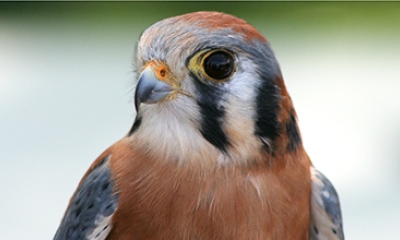
Formerly known in American literature as the Sparrow hawk, this is the smallest (dove-sized) and most familiar and abundant member of the family Falconidae in North America and one of the easiest raptors to observe.
It has two considerably different plumages: adult male and female and juvenile males differ somewhat from adult males until post-juvenile mold in fall. Adult males have rufous backs and tails with blue-grey upper wing coverts. The tail has a wide black subterminal band. Juvenile males are similar to adult males but have heavily streaked breasts. Females are slightly larger than males and have reddish-brown backs and upper wing coverts that are barred with dark brown.
These birds soar with their long and pointed wings flat, and regularly hover over open and partly open country with scattered trees, including cultivated lands and occasionally suburban areas.
The American kestrel breeds statewide in open terrain from sea level to the alpine zone in the mountains.
Hear the call of the American kestrel
Photo by Cathy Nowak, ODFW

With short pointed wings and long narrow tails, these small falcons are well built for fast pursuit and mid-air attacks. Sexes differ in color and size, with adult males about 25 percent smaller by weight than females. Males range from blackish gray to pale blue-gray on the back with a reddish wash along sides of the breast and a banded tail; females have brownish backs.
In winter, it can be found throughout the state in open or semi-open habitats, but it is most regular near major estuaries, lakes, reservoirs, and occasionally in cities where food supplies are reliable. For nesting, Merlins use old crow, raven, hawk, or magpie nests, tree cavities, or cliff ledges. They hunt a variety of small to medium-sized birds, usually specializing in one or two locally abundant species.
Photo by Bob Swingle, ODFW

The Turkey vulture, known locally as a "buzzard," is a common sight spring through fall throughout the state, except in the highest mountains and featureless desert expanses in summer where they are uncommon. Seeing Turkey vultures returning is a welcome sign of spring.
Turkey vultures are large-winged soaring birds with overall dark plumage except for a silvery sheen on the undersides of the flight feathers. Adults have small, featherless, red heads, while juveniles have gray heads.
The Turkey vulture is a common to abundant transient throughout the state and an uncommon to common summer resident except in high mountains. It is most common at lower elevations and in large valleys.
Debate raged for 140 years whether this species could locate its usual foul meals by smell or whether it depended on visual cues. While it is now clear that Turkey vultures have a sense of smell, the question of its power is still being debated.
Photo by Dave Budeau, ODFW
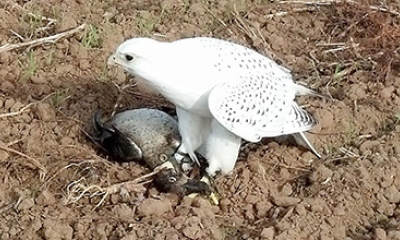
This is a large and power falcon. The majority of Gyrfalcons seen in Oregon are immatures or adults of the "gray" type, but there are several reports of "white" birds. The Gyrfalcon is a regular winter visitant to Oregon. The majority of sightings come from coastal and Willamette Valley lowlands near waterfowl concentrations. Individuals have been seen chasing and feeding on geese, ducks and gulls.
Gyrfalcons forage by flying low over the ground and flushing prey, then often giving spectacular tail chases. If a bird refuses to flush the hunt is usually unsuccessful. East of the Cascades it occurs around open meadowlands and prairies, as well as about waterfowl concentrations.
Photo by Bob Welle
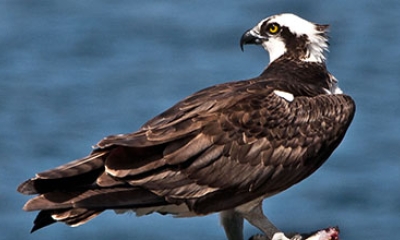
This large bird of prey is dark above, white below, and has a visible dark spot at the wrist of the wing when flying. The head is black and white. Juveniles have buffy-tipped dark feathers above. In flight, the wings have a noticeable angle or "crook."
This highly migratory fish-eating species is frequently found nesting along larger rivers, lakes, and reservoirs. A large bulky nest at the very top of a live, broken top,or dead tree and more recently on utility poles, channel markers, pilings, and cell phone towers near fishable waters is good evidence of Ospreys.
The Osprey breed statewide, in Oregon, except in arid treeless regions of the southeast part of the state. Nests are usually located within two miles of water with an accessible fish population.
In the summer of 2017, the Oregon Legislature declared the Osprey as Oregon's State Raptor.
Hear the call of the Osprey and learn more interesting facts on our Living with Wildlife, Osprey page.
Photo by Blaine Fanning
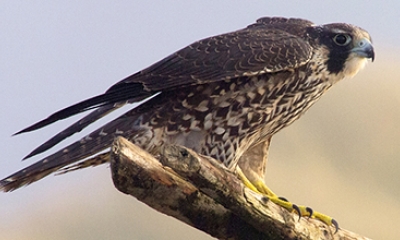
Peregrine falcons are among the most charismatic and noted of the world's birds. They are described as the fastest animal on the planet, and have been recorded reaching speeds in excess of 240 miles an hour in dives after prey.
They are one of Oregon's boldest raptors, and have been observed usurping active Golden eagle nest sites, stealing fish from Ospreys and ground squirrels from adult Bald eagles who stray into their territory. It has, for perhaps 4,000 years, been used by falconers because of its skill in capturing game birds in tandem hunts with humans.
Peregrines are medium-sized raptors, and share characteristics with all falcons: bill conspicuously toothed and notched, presence of a nasal cone, and pointed wings for swift flight.
In Oregon, Peregrines occur as resident and migratory populations. It is a regular breeder and uncommon migrant.
The Peregrine falcon is an Oregon Conservation Strategy Species in the Coast Range and Northern Basin and Range ecoregions.
Hear the call of the Peregrine falcon
Photo by Tim Moore
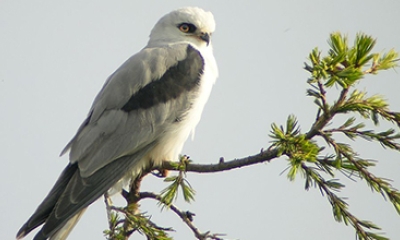
As the winter day turns to dusk, White-tailed kites drop into their roosts and Short-eared owls rise to take their place on the local hunting grounds. White-tailed kites in Oregon often roost communally in winter, but they disperse in early spring and are more difficult to find during the breeding season.
By day, they are conspicuous as they hover over rural fields searching for prey, in part because of their pale appearance. The tail is entirely white, as are the head and the underparts. Dark crescents on the underwing can be seen when a bird is flying or hovering. Above, they are light gray with black shoulder patches. Young-of-the-year are easily distinguished by a rusty band across the breast, rusty markings on the head, and a thin gray band near the end of the tail.
It is probably a permanent resident in the Willamette, Umpqua, Rogue, Illinois, and Applegate valleys and along the coast. The highest concentration of known nest locations is in the Medford, Jackson County area.
Hear the call of the White-tailed kite
Photo by Len Blumin, Flickr
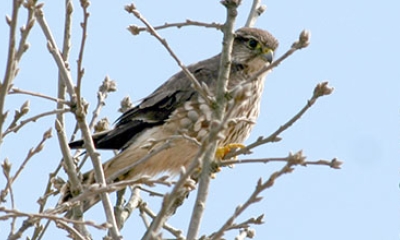
One of the most impressive sights in the unforested regions east of the Cascades is a Prairie falcon strafing a Belding's ground squirrel colony repeatedly at full speed in hopes of catching one emerging from its burrow at just the wrong moment.
Prairie falcons are most common in rimrock country where they nest, but may travel great distances in search of prey.
Prairie falcons are large, sandy brown above and off-white with variable amounts of streaking below. The face has a vertical stripe below the eye, as do many falcons. In flight, the long, pointed wings and long tail identify it as a falcon.
Hear the call of the Prairie falcon
Photo by Kathy Munsel, ODFW
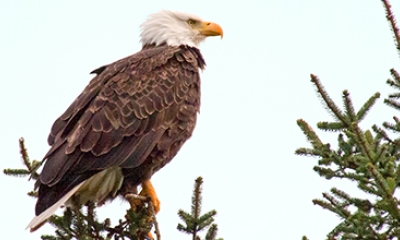
The Bald eagle is one of eight species of sea-eagle worldwide, and the only sea-eagle found throughout North America. It is one of the most studied North American birds.
Large size, wingspan of six-and-a-half to eight feet, and the contrast of white head and tail, and yellow eyes, beak, and leg, to dark brown body and wings make the adult Bald eagle one of our most distinctive raptors. Six age-related plumages have been recognized; adult plumage is acquired at four-and-a-half to five years of age.
Sexes have similar plumages, but females are larger than males, and the sex of individuals in breeding pairs can usually be determined by size when they perch close together.
The Bald eagle breeds in 32 of 36 Oregon counties and is found throughout the state during non-breeding season. The Bald eagle was brought back from the brink of extinction when the federal government banned the use of DDT in 1972 and listed the eagle under the federal Endangered Species Act in 1978. Recovery took decades and involved agencies, organizations, politicians, landowners, and the American public. It was removed from the federal ESA in Oregon in 2007 and removed from the Oregon state threatened species list in 2012.
Hear the call of the Bald eagle
Photo by Tim Moore
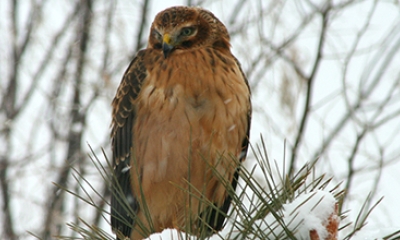
The Northern harrier is a slender, medium-sized hawk characterized by a noticeably long tail, bold white rump patch, and owl-like face. Commonly encountered in large expanses of open country, its main hunting technique is through use of a distinctive buoyant, gliding flight low over the ground that relies heavily on visual as well as auditory cues to detect prey.
The larger females have rich brown upperparts while adult males are mostly light to medium gray, sometimes appearing almost ghostly silvery-white. Males are noted for their high-spirited and acrobatic courtship displays, in particular a series of dives and barrel rolls in multiple loops that serve as a means of advertising territory occupancy.
The Northern harrier is common during summer and migration in open habitats east of the Cascades, with numbers decreasing in most areas during winter. An exception is in the lowlands of Umatilla and Morrow counties, where the harrier is common in winter due to an influx of wintering birds. The harrier also remains common year-round in the Klamath Basin and is the second most commonly encountered wintering raptor at Malheur National Wildlife Refuge.
Hear the call of the Northern harrier
Photo by Cathy Nowalk, ODFW
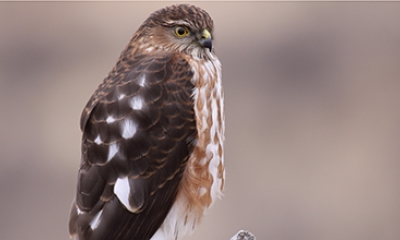
The Sharp-shinned hawk is North America's smallest and most migratory accipiter.
As a hunter of songbirds (and sometimes young chickens) it historically endured harsh reproach, and was often depicted as a blood-thirsty villain, even by some ornithologists. Across the U.S., many thousands were shot in the first half of the 20th century. But prevailing attitudes have changed, and today a glimpse of this slender, secretive hawk darting through the treetops is more likely to elicit admiration than malice.
Adult plumage, nearly identical to the slightly larger Cooper's hawk, consists of slate gray back and wings, breast and sides barred with rufous and white, and a black and gray banded tail. The eyes of adults are a striking crimson. Males average about 57 percent the body mass of females.
The Sharp-shinned hawk is an uncommon breeder throughout Oregon in forested areas from sea level to timberline. It is least common in the breeding season in southeastern Oregon, where most forests are widely disjunct and separated by arid brushland. It is an uncommon transient and winter visitor across the state in wooded areas or semi-open country. During fall migration, many birds move through the state to wintering grounds farther south.
Hear the call of the Sharp-sinned hawk
Photo by Charlotte Ganskopp

Cooper's hawks are smallish "bird hawks" (slightly smaller than American Crows) with rounded wings, a long rounded tail, and long yellow legs.
This is the mid-sized accipiter nesting in Oregon and is larger than the Sharp-shinned hawk, but smaller than the Northern goshawk.
The usual mode of flight consists of several rapid wing-beats alternating with brief periods of sailing. Juveniles are dark above with underparts streaked vertically while adults tend to have a bluish cast to their gray upperparts. The long tail is barred dark and light with narrow whitish band at the tip.
It is an uncommon breeder in forests and woods through the state except in arid treeless areas of southeastern Oregon. It is also an uncommon transient and winter visitor statewide.
Hear the call of the Cooper's hawk
Photo by Tim Moore

Of the three U.S. and Canadian forest hawks known as accipiters, this is by far the most impressive because of its size and aggressiveness. Like others of the genus it is morphologically adapted to maneuvering through forest landscapes and usually uses an ambush approach to capturing prey; although if prey tries to escape, it quickly pursues.
From Turkey to Japan, goshawks are favored over falcons for falconry, and a limited number of permits are issued in Oregon for taking goshawks for falconry purposes.
The Northern goshawk has short, broad, round-tipped wings and a long tail. It is approximately the size of the Common raven. Adult plumage color is generally silver-gray on the upperparts and barred pale grayish-white on the underparts. Immatures are generally brown with strong striping on the underparts. An eye-stripe, if present, helps identify a goshawk. When perched, the short wings of the goshawk do not reach the midpoint of the tail. Tails of both adults and immatures have dark bands.
It is an uncommon to fairly common permanent resident in suitable habitat between 1,900 - 6,100 foot elevation in forested portions of the Cascade, Blue, and Klamath mountains.
The Northern goshawk is an Oregon Conservation Strategy Species in the East Cascades and West Cascades ecoregions.
Hear the call of the Northern goshawk
Photo by Charlotte Ganskopp

